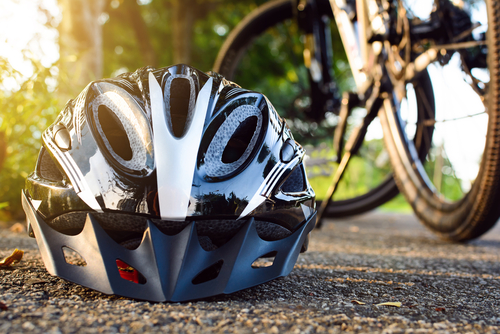When I was 18 years old I was knocked off my bicycle in a road traffic accident (or road traffic collision to use the modern parlance). I hit the tarmac quite hard; landing head first and sliding along the ground a bit before coming to a stop. As I lay on my side staring at the sky I could taste salty liquid trickling down my throat. When I turned my head a straw-coloured liquid dripped out of my nose to form a little puddle. That’s when I knew I had a fractured skull.
When I tell people about this accident they often ask if I was wearing a helmet. And the answer is no. Bicycle helmets are we know them today had not been invented in 1983. They are an American invention that we imported into Britain through the late 80’s and early 90’s. The closest thing to a bike helmet that I remember from that era was a leather strappy headgear that professional cyclist sometimes wore.
The Times They Are A-Changin’…
I was reminded of this last weekend when I went out for a ride on my touring bike. This time with a helmet on. Times change, cultural norms change. Something that would have seemed exceptional and even weird in 1983 has become unremarkable and commonplace. Arguable it is unusual to see cyclist on the road these days without a helmet. And for very good reason. You can break an arm or a leg and the chances are you will survive. But break your head and your fate is in the lap of the gods.
Wearing seat belts in cars is another example of a safety-related behaviour that has become commonplace. I, like some of you, grew up at a time when wearing seat belts in cars was not mandatory. Some older cars didn’t even have them fitted. Front or back. But times change, manufacturing standards changed and the law changed. As a result I have worn a seat belt in cars for all of my adult life. I am habituated to wearing one. It is the first thing that goes on when I get in a car and the last thing that comes off before I get out. I am so habituated to wearing one that if I try to drive a car without one on I feel physically uneasy. Like a bit of my brain is screaming out: No! Stop! What do you think you are doing? Foreign taxi drivers frequently give me dirty looks when I put one on – because they think I have just insulted their driving abilities.

In both of the examples above cultural norms have shifted and as a result many people have changed their default behaviour to follow suit. However, the two examples given are not identical, because in one case the law has intervened to mandate the wearing of seat belts in cars whereas in the other there is no legal compulsion. People wear cycle helmets because they want to; not because they have to. Cultural norms play a big part in influencing both behaviours. Which is why the health and safety culture of organisations is so important.
Inevitably there are always going to be some hard nuts to crack. By that I mean individuals and groups who manage to maintain their ‘old’ views, opinions and behaviours in spite of shifting cultural norms. You do see cyclists without head protection and you do see car drivers not wearing seat belts. This kind of intransigent behaviour can be quite a challenge for an organisation that is trying to shift its culture and change behaviour. In fact it is a bare-faced challenge that demands some sort of response. The response might be gentle or it might be forceful, but the challenge cannot be ignored.
To quote one management philosophy: “change the people or change the people”.
But Not Everywhere it Would Seem…
If all of this reminiscing about ‘the good old days’ seems rather nostalgic it was brought on by a recent news article on the BBC website about the new drink and drugs code of conduct that has recently been introduced at Lloyds of London, the City of London insurance market (see here). I find the idea that any large organisation would not already have a clear policy of prohibition astonishing. Irrespective of any safety risk. The cultural norms on this issue shifted decades ago – but not at Lloyds of London apparently.
They really are the hard nuts.
[Incidentally having lived through the 80’s I can attest that they weren’t as much fun as some people would have you believe. Thatcher’s Britain, the Falklands War, the Miners’ Strike and a collection of some of the grimmest national disasters on record is what I remember. And yes there was some good music, but an awful lots of terrible stuff too. I mean Sigue Sigue Sputnick! Really? I rest my case.]
…And Finally Ronnie
As I lay on the tarmac contemplating the cerebrospinal fluid dripping from my nose a very nice gentleman approached me and offered to help. “I’m a trained first aider” he said reassuring. Knowing that I had done myself a serious injury (I hit the ground fast enough to remove the soles off my trainers and the back pockets off my jeans), and not wanting to be moved, my response was slightly less friendly.
“ *#&$ Off and don’t touch me!”
A few years later I needed to do an emergency first-aid training course to pick up some seasonal work. Guess who the instructor was…
He was very kind and forgave my indiscretion.
–
Dr Jim Phelpstead BSc, PhD, CMIOSH

